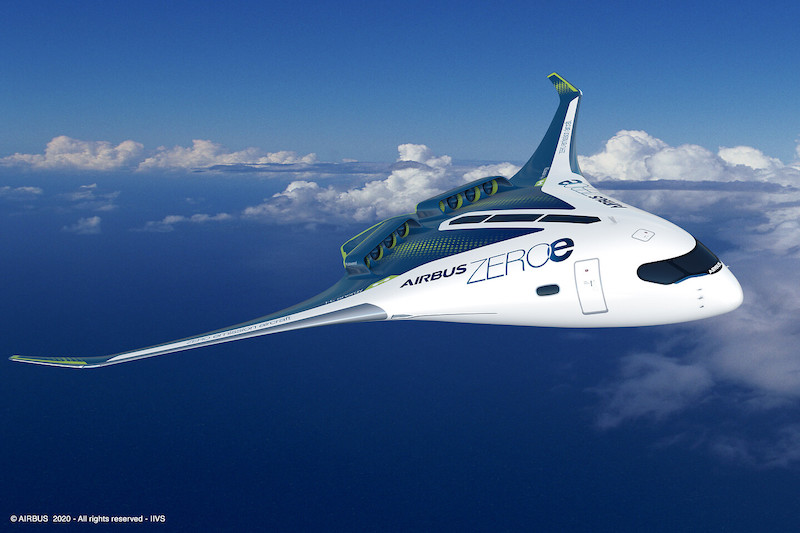The CEO of Airbus, currently the largest aircraft manufacturer in the world, says he believes hydrogen-powered airplanes are the “ultimate solution” to the unfair criticism of the aerospace industry as a planet-polluting monster.
The World Wildlife Fund says the aviation industry is “one of the fastest-growing sources of the greenhouse gas emissions driving global climate change”, adding that air travel is “currently the most carbon intensive activity an individual can make”.
These things have been true for many decades, but with completely crazy extreme weather systems attacking different parts of the world on an almost weekly basis over the past couple of years, the search for sustainable aviation fuels (SAF) has taken on a new urgency.
In an interview with CNBC, Guillaume Faury says the aircraft that Airbus is now making run on 50 percent sustainable aviation fuel, but said more needs to be done.
Faury says: “We need to see the SAF industry moving forwards, being developed, being grown to serve airlines and to be able to use that capacity of 50 percent of SAF. We’ll go to 100 percent by the end of the decade.”
“The next one is looking at the mid-term and long-term future to bring to the market the hydrogen plane because this is really the ultimate solution.”
But he adds that in order to get to hydrogen-powered planes, a lot of engineering, research and capital commitments would be required.
Slightly ahead of its time
Towards the end of 2020, Airbus revealed three concepts for the world’s first zero-emission commercial aircraft which could enter service by 2035.
These concepts each represent a different approach to achieving zero-emission flight, exploring various technology pathways and aerodynamic configurations in order to support the company’s ambition of leading the way in the decarbonisation of the entire aviation industry.
All of these concepts rely on hydrogen as a primary power source – an option which Airbus believes holds exceptional promise as a clean aviation fuel and is likely to be a solution for aerospace and many other industries to meet their climate-neutral targets.
At the time, Faury said: “This is a historic moment for the commercial aviation sector as a whole and we intend to play a leading role in the most important transition this industry has ever seen. The concepts we unveil today offer the world a glimpse of our ambition to drive a bold vision for the future of zero-emission flight.
“I strongly believe that the use of hydrogen – both in synthetic fuels and as a primary power source for commercial aircraft – has the potential to significantly reduce aviation’s climate impact.”
The three concepts – all codenamed “ZEROe” – for a first climate neutral zero-emission commercial aircraft include:
A turbofan design (120-200 passengers) with a range of 2,000+ nautical miles, capable of operating transcontinentally and powered by a modified gas-turbine engine running on hydrogen, rather than jet fuel, through combustion. The liquid hydrogen will be stored and distributed via tanks located behind the rear pressure bulkhead.
A turboprop design (up to 100 passengers) using a turboprop engine instead of a turbofan and also powered by hydrogen combustion in modified gas-turbine engines, which would be capable of traveling more than 1,000 nautical miles, making it a perfect option for short-haul trips.
A “blended-wing body” design (up to 200 passengers) concept in which the wings merge with the main body of the aircraft with a range similar to that of the turbofan concept. The exceptionally wide fuselage opens up multiple options for hydrogen storage and distribution, and for cabin layout.
Decisive action required
Faury said: “These concepts will help us explore and mature the design and layout of the world’s first climate-neutral, zero-emission commercial aircraft, which we aim to put into service by 2035.
“The transition to hydrogen, as the primary power source for these concept planes, will require decisive action from the entire aviation ecosystem. Together with the support from government and industrial partners we can rise up to this challenge to scale-up renewable energy and hydrogen for the sustainable future of the aviation industry.”
In order to tackle these challenges, airports will require significant hydrogen transport and refueling infrastructure to meet the needs of day-to-day operations.
Support from governments will be key to meet these ambitious objectives with increased funding for research and technology, digitalisation, and mechanisms that encourage the use of sustainable fuels and the renewal of aircraft fleets to allow airlines to retire older, less environmentally-friendly aircraft earlier.
You might also like…
Credit: Source link





















